What vitamins are in bell pepper and how is it useful for the body
Bulgarian pepper - one of the most versatile vegetables with a rich vitamin and mineral composition. At one time, he came a long way from the hot countries of Central America, before falling into the skillful hands of European, or rather, Bulgarian breeders, who bred the variety that is familiar to us. Green, yellow, red peppers are used both for the preparation of various culinary masterpieces, and as an independent dish.
You will learn about what vitamins are contained in bell pepper, about the beneficial properties and dangers of the product from the article.
The content of the article
Bell pepper
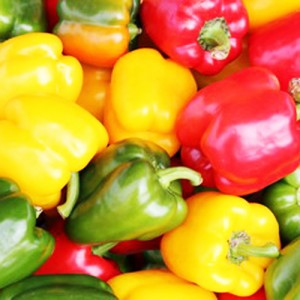
Bell pepper belongs to the nightshade family. That is, it is a direct relative of eggplants, potatoes and tomatoes. It got its name thanks to the efforts of Bulgarian breeders who bred a large-fruited variety. Another name for the product is sweet pepper or paprika.
The homeland of this wonderful vegetable is Central America. Somewhere in the vastness of Mexico and Colombia, wild peppers are still found. After the discovery of the new mainland, the conquerors took with them to Europe the unprecedented wealth of the Indians, among whom was pepper.
Interesting... It is noteworthy that in addition to eating, people used seeds as a weapon to scare away wild animals and enemy conquerors. Indians sprinkled seeds on embers, which led to the appearance of acrid smoke.
Initially, the predecessor of the bell pepper ended up in Portugal and Spain. Then it appeared in other European countries and the Middle East. Paprika loves the sun, so it is actively cultivated in countries with hot and temperate climates.
Bell pepper is widely used in cooking. Consumed fresh, salted, pickled, canned, baked, fried, stuffed. The vegetable is wonderfully combined with other products, retains about 30% of nutrients during heat treatment.
Composition and nutritional value
The calorie content of paprika depends on the color:
- in red - 31 kcal;
- in yellow - 27 kcal;
- in green - 20 kcal.
That is why the vegetable is considered dietary and is popular with adherents of a healthy diet and all kinds of diets to reduce body weight.
Bell pepper contains:
- water - 90 g;
- proteins - 1.2 g;
- carbohydrates - 5 g;
- fats - 0.3 g;
- fiber - 3.5 g

Vitamins and minerals
Sweet pepper is a unique product that contains a lot of nutrients:
- beta carotene (vitamins A);
- thiamin (vitamin B1);
- riboflavin (vitamin B2);
- niacin (vitamin B3);
- pantothenic acid (vitamin B5);
- pyridoxine (vitamin B6);
- folic acid (vitamin B9);
- ascorbic acid (vitamin C);
- tocopherol (vitamin E);
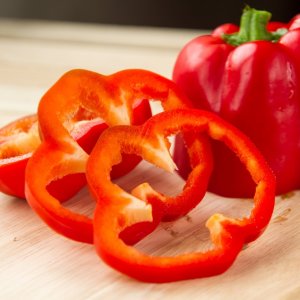
- phylloquinone (vitamin K);
- biotin (vitamin H);
- flavonoids (vitamin P);
- magnesium;
- chlorine;
- calcium;
- sodium;
- potassium;
- sulfur;
- manganese;
- iron;
- iodine;
- zinc;
- phosphorus;
- copper;
- molybdenum;
- fluorine.
The benefits and harms of bell pepper
In the 30s of the XX century, Albert Szent-Gyorgyi derived vitamin C in crystalline form precisely from bell peppers, for which he was awarded the Nobel Prize. And this is not surprising, because the fleshy vegetable contains five times more ascorbic acid than citrus fruits.
100 g of red pepper pulp contains 150 mg of vitamin. For example, the daily requirement of an adult is about 60 mg. At the same time, an overdose of a valuable antioxidant does not threaten us, since the excess is actively excreted from the body along with urine.Interestingly, when cooked, it loses less vitamin C compared to other vegetables and fruits, because it cooks quickly enough.
Due to the high content of B vitamins, calcium, potassium, iron and magnesium, pepper improves overall health, the state of the nervous system, musculoskeletal system. With regular use, it normalizes blood pressure and protects blood vessels.
Bell pepper contains a lot of fiber (2 g per 100 g), which has a beneficial effect on the condition of the gastrointestinal tract, facilitates the process of digestion, has a diuretic effect, and accelerates the process of cleansing the body.
Beta-carotene and ascorbic acid increase the body's defenses, accelerate the growth of nails and hair, improve vision, the condition of the skin and mucous membranes.
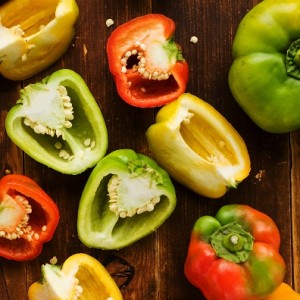 B vitamins normalize sleep, relieve depression, stress, dermatitis, diabetes mellitus, relieve fatigue, edema. Vitamin P strengthens the walls of blood vessels, reduces permeability.
B vitamins normalize sleep, relieve depression, stress, dermatitis, diabetes mellitus, relieve fatigue, edema. Vitamin P strengthens the walls of blood vessels, reduces permeability.
Iron, zinc, calcium, phosphorus, iodine and magnesium increase the level of hemoglobin, improve the quality of life in osteoporosis, regulate the sebaceous and sweat glands, and eliminate foci of alopecia.
Paprika contains capsaicin, which normalizes the stomach and pancreas, thins the blood, reducing the risk of thrombosis, and regulates blood pressure.
Important... Green bell peppers contain P-coumaric acid, which removes carcinogens from the body. Lycopene in red peppers prevents the development of cancer. Fleshy fruits reduce the risk of prostate cancer due to their high content of ascorbic acid.
Eating paprika in food has a beneficial effect on the health of the respiratory system. Manganese, potassium, magnesium, vitamin C prevent the development of respiratory infections that lead to asthma, pneumonia and emphysema.
The vegetable helps to preserve the youthfulness of hair and skin, stimulates collagen production, and protects against ultraviolet radiation.
Folic acid in pepper reduces the risk of neural tube defects in a baby. Therefore, doctors advise not to exclude the product from the diet during pregnancy.
Bell peppers harm the body if a person suffers:
- diseases of the cardiovascular system - hypertension, ischemia, tachycardia;
- hemorrhoids;
- pathologies of the gastrointestinal tract (ulcers, erosion, gastritis);
- disorders of the kidneys and liver;
- epilepsy.
The fact is that paprika is rich in coarse fiber in essential oils. These components worsen the condition of a person with a history of these diseases.
However, sweet peppers have much more positive properties than negative ones. Doctors advise taking into account the state of health before consuming the fruit.
The content of vitamins, minerals, depending on the color of the pepper
The composition of paprika of different colors is approximately the same. But green fruits contain more lutein, red - capsanthin, yellow - violaxanthin. These are antioxidants that neutralize the harmful effects of free radicals on the body. With their deficiency, damage to cells and tissues occurs, signs of external and internal premature aging appear.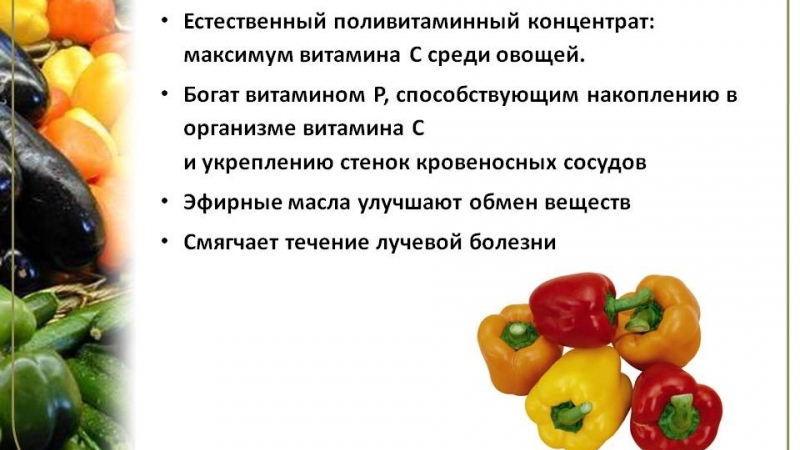
reference... Italian scientists conducted a study trying to find out which pepper color people find the sweetest. Most of the participants in the experiment pointed to yellow fruits. Although red peppers contain a lot more sugar. Apparently, yellow evokes associations with sun, sweetness and ripeness.
Red
Red paprika contains a lot of beta-carotene and vitamin C. Even 100 g of pulp can satisfy about 70% of a person's need for ascorbic acid. With regular use of the vegetable, we get: an even, healthy complexion, smooth skin, elastic vessels, good eyesight, increased mental abilities, including memory.
Yellow
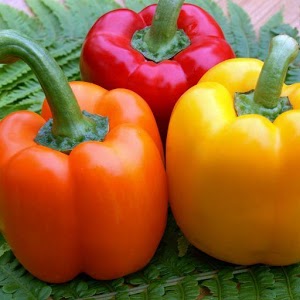 Yellow peppers are high in vitamin E, lutein and zeaxanthin (an antioxidant that neutralizes free radicals in the retina and improves vision).
Yellow peppers are high in vitamin E, lutein and zeaxanthin (an antioxidant that neutralizes free radicals in the retina and improves vision).
Yellow fruits contain more rutin, calcium and phosphorus, which strengthen bone tissue and blood vessels.
Green
Folic acid is abundant in green peppers. One fruit covers about 25% of the daily requirement for this vitamin. Therefore, green paprika is recommended to be consumed by women at the stage of planning pregnancy or bearing a fetus.
Fruits of this color improve mood, have a positive effect on the nervous system and the process of hematopoiesis. Green pepper is a source of vitamin E, which is responsible for youthful skin and an attractive appearance.
reference... The teachings confirmed the information that green fruits contain substances that can reduce the risk of developing cancer.
Eating bell peppers
It is advisable to use paprika of any color fresh, because it contains the greatest amount of nutrients. Add juicy, crispy pulp to salads, prepare snacks, slices, soups, borscht, stuff, bake, marinate, canning.
There are so many recipes for cooking this wonderful vegetable that every housewife will find the best way to cook it. To prepare peppers for the winter and preserve the beneficial properties of the product, use the freezing method. When thawed, the pulp does not lose its shape and does not creep into an unsightly mess.
Contraindications
Bell pepper is forbidden to use for such diseases as:
- tachycardia;
- hemorrhoids;
- colitis;
- ulcerative lesions of the stomach and duodenum;
- gastritis;
- increased acidity of the stomach;
- pathology of the kidneys and liver in the acute stage;
- excessive excitability of the central nervous system;
- ischemia of the heart;
- epilepsy.
Read also:
How to freeze bell peppers for the winter.
How to cook pickled tsitsak pepper for the winter.
How to cook Ratunda pepper with honey for the winter: preservation recipes.
Conclusion
Bell pepper has beneficial properties that have a beneficial effect on human health. Vitamins and minerals prevent the development of diseases of the digestive, cardiovascular, and musculoskeletal systems. Antioxidants reduce the risk of cancer and improve skin condition for a blooming appearance.